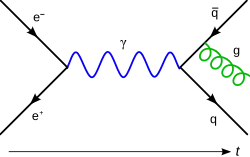Quantum physics
| Subject classification: this is an information technology resource. |
| Educational level: this is a tertiary (university) resource. |
| Subject classification: this is a physics resource. |
| Subject classification: this is a chemistry resource. |
| Subject classification: this is a mathematics resource. |
| Physics portal |
| Mathematics portal |
Welcome to the Department of Quantum Physics!
COLLEGE OF SCIENCES
School of Physical Sciences · School of Life Sciences · SchoolEngineering and Technology · School of Mathematics
Biology · Chemistry · Computer Science ·Economics · Mathematics· Physics and Astronomy · - Quantum physics, Wikiversity projects on the interpretation of quantum theories:

Feynman Diagram for Gluon Radiation
Welcome also to the School of Physical Sciences!
·
Welcome
|
Welcome to Wikiversity, Quantum physics!
You can contact us with questions at the colloquium or get in touch with me personally if you would like some help. Remember to sign your comments when participating in discussions. Using the signature icon We invite you to be bold and assume good faith. Please abide by our civility, privacy, and terms of use policies. To find your way around, check out:
To get started, experiment in the sandbox or on your userpage. See you around Wikiversity! --~~~~ |
External links
- Quantum Physics Collaboration
- Quanta- a new OJS journal
- PlanetPhysics.org' MediaWiki version 1.17 Quantum Book Projects
- Q-logics of Quantum Automata
- Quantum Algebra Textbook:"Quantum Algebra, Quantum Computers and Symmetries", 2011. 727 pages, free downloads, OpenSource, 27Mb PDF file
- Łukasiewicz, or Polish, Notation
- Quantum Physics (UCSD Physics 130), course notes by Jim Branson (2013)
Bibliography
- [1]Chester, Marvin (1987) Primer of Quantum Mechanics. John Wiley. ISBN 0-486-42878-8
- [2] Griffiths, David J. (2004). Introduction to Quantum Mechanics (2nd ed.). Prentice Hall. ISBN 0-13-111892-7. OCLC 40251748. A standard undergraduate text.
- [3] Richard Feynman, 1985. QED: The Strange Theory of Light and Matter, w:Princeton University Press. ISBN 0-691-08388-6. Four elementary lectures on w:quantum electrodynamics and w:quantum field theory, yet containing many insights for the expert.
- [4] Dirac, P. A. M. (1930). The Principles of Quantum Mechanics. ISBN 0-19-852011-5. The beginning chapters make up a very clear and comprehensible introduction.
- [5] Albert Messiah, 1966. Quantum Mechanics (Vol. I), English translation from French by G. M. Temmer. North Holland, John Wiley & Sons. Cf. chpt. IV, section III.
- [6] Omnès, Roland (1999). Understanding Quantum Mechanics. Princeton University Press. ISBN 0-691-00435-8. OCLC 39849482.
- [7] von Neumann, John (1955). Mathematical Foundations of Quantum Mechanics. Princeton University Press. ISBN 0-691-02893-1.
- [8] Hermann Klaus Hugo Weyl, FRS, 1950. The Theory of Groups and Quantum Mechanics, Dover Publications.
- [9] D. Greenberger, K. Hentschel, F. Weinert, eds., 2009. Compendium of quantum physics, Concepts, experiments, history and philosophy, Springer-Verlag, Berlin, Heidelberg.
- ... more to come
- [12] Brown R (2004) Crossed complexes and homotopy groupoids as non commutative tools for higher dimensional local-to-global problems. In: Proceedings of the Fields Institute Workshop on Categorical Structures for Descent and Galois Theory, Hopf Algebras and Semiabelian Categories, September 23-28, 2004, Fields Institute Communications 43:101-130.
- [13] Brown R, Hardie K A, Kamps K H, and Porter T (2002) A homotopy double groupoid of a Hausdorff space. Theory and Applications of Categories 10:71-93.
- [14] Georgescu G, and Popescu D (1968) On Algebraic Categories. Revue Roumaine de Mathematiques Pures et Appliquées 13:337-342.
- [15] Georgescu G, and Vraciu C (1970) On the Characterization of Łukasiewicz Algebras. J. Algebra, 16 (4):486-495.
- [16] Georgescu G (2006) N-valued Logics and Łukasiewicz-Moisil Algebras. Axiomathes 16 (1-2): 123-136.
- [17] Landsman N P (1998) Mathematical topics between classical and quantum mechanics. Springer Verlag, New York.
Quantum Logics
Notation Table
Polish- or Łukasiewicz's notation for logic
- The table below shows the core of w:Jan Łukasiewicz's notation for w:sentential logic, or Propositional Logic. The "conventional" notation did not become so until the 1970s and 80s. Some letters in the Polish notation table means a certain word in Polish, as shown:
| Concept | Conventional notation | Polish notation | Polish / English word |
|---|---|---|---|
| w:Negation | Nφ | negation (No)} | |
| Conjunction | Kφψ | conjunction | |
| w:Disjunction | Aφψ | alternate OR=disjunction | |
| w:Material conditional | Cφψ | implication | |
| w:Biconditional | Eφψ | equivalence' | |
| w:Falsum | O | False value | |
| w:Sheffer stroke | Dφψ | Sheffer stroke | |
| Possibility | Mφ | contingent | |
| Necessity | Lφ | Necessary condition | |
| w:Universal quantifier | Πpφ | kwantyfikator ogólny | ANY:
For all p, \phi|Universal quantifier |
| Existential quantifier | Σpφ | Exists |
- Note that the quantifiers ranged over propositional values in Łukasiewicz's work on many-valued logics.
- Portal:Mathematics
- Portal:Physical Sciences
See also
- Quantum mechanics
- Quantum biology
- Quantum mechanics
- Photosynthesis
- Mathematical biophysics
This article is issued from Wikiversity. The text is licensed under Creative Commons - Attribution - Sharealike. Additional terms may apply for the media files.